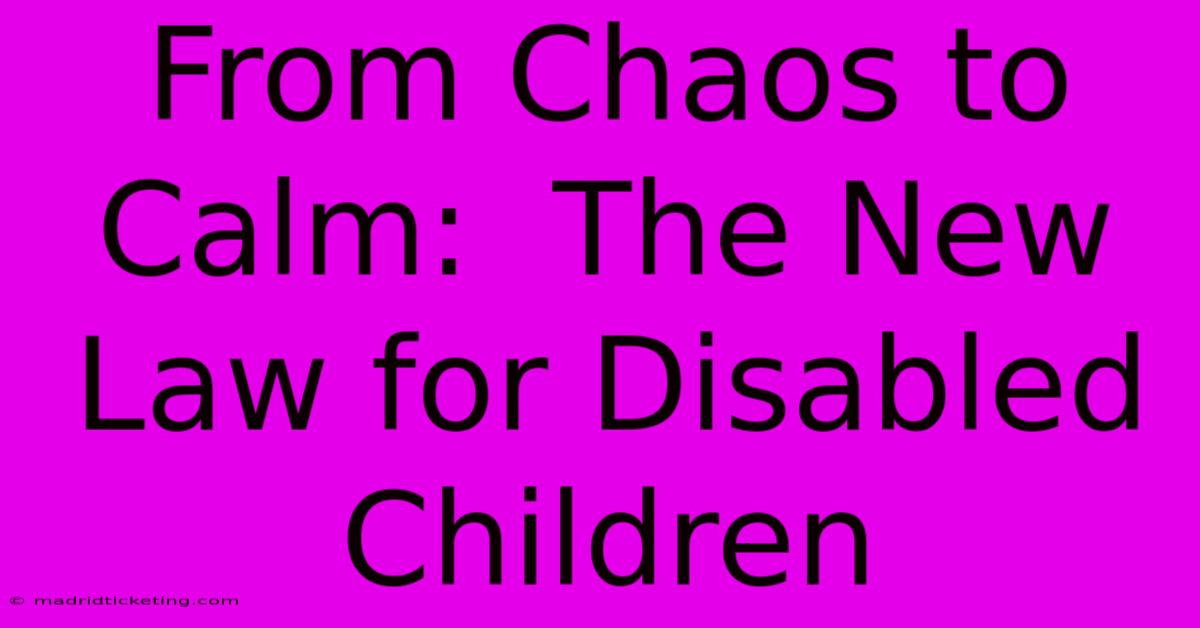From Chaos To Calm: The New Law For Disabled Children

Table of Contents
From Chaos to Calm: The New Law for Disabled Children
Navigating the world as a parent of a disabled child can often feel like traversing a chaotic landscape. Mountains of paperwork, endless appointments, and the constant struggle for appropriate support can leave families feeling overwhelmed and exhausted. But there's a glimmer of hope on the horizon. New legislation is aiming to bring order to this chaos and provide much-needed support for disabled children and their families. This article explores the key aspects of this transformative law and how it promises to bring calm to a previously turbulent journey.
Understanding the Challenges Faced by Families of Disabled Children
Before diving into the specifics of the new law, it's crucial to understand the challenges families currently face. These include:
- Access to appropriate services: Finding and accessing the right therapies, educational support, and healthcare can be incredibly difficult. Waiting lists are often long, and the process of navigating different agencies and systems can be confusing and frustrating.
- Financial strain: The cost of specialized equipment, therapies, and adapted living arrangements can place an enormous financial burden on families.
- Lack of support and understanding: Families often face a lack of understanding and support from their communities, schools, and even healthcare professionals. This isolation can exacerbate feelings of stress and helplessness.
- Inconsistent support across regions: The level of support available for disabled children can vary drastically depending on geographical location, leading to inequalities in access to essential services.
The New Law: A Beacon of Hope
The new law represents a significant step towards addressing these challenges. Its core tenets revolve around:
1. Early Intervention and Support:
The law emphasizes early identification and intervention, recognizing the importance of providing support as early as possible. This includes:
- Improved screening and diagnostic processes: Streamlining the process to ensure children receive timely diagnoses and access to appropriate support services.
- Enhanced funding for early intervention programs: Providing increased funding for programs designed to support the development and well-being of disabled children from a young age.
2. Personalized Support Plans:
The law mandates the creation of individualized education programs (IEPs) and support plans tailored to the specific needs of each child. This ensures that:
- Children receive the right support at the right time: Support is individualized to address the unique challenges and strengths of each child.
- Families are actively involved in the planning process: Parents and carers play a central role in determining the best course of action for their child.
- Regular reviews and adjustments: Support plans are regularly reviewed and adjusted to meet the evolving needs of the child.
3. Financial Assistance and Resources:
The new law aims to alleviate the financial burden on families by:
- Increased funding for assistive technology and equipment: Making necessary equipment more accessible and affordable.
- Financial support for respite care: Providing families with access to short-term breaks to prevent caregiver burnout.
- Support for transportation and accessibility: Assisting families with transportation costs and ensuring accessibility to services and facilities.
4. Improved Communication and Coordination:
The law seeks to improve communication and coordination between different agencies and professionals involved in supporting disabled children. This involves:
- Establishing a single point of contact: Creating a centralized system to make navigating different services easier.
- Improving data sharing and information exchange: Ensuring all professionals have access to the relevant information to provide coordinated support.
The Path to Calm: Implementation and Future Outlook
While the new law offers significant promise, its success depends on effective implementation. This requires:
- Adequate funding and resources: Sufficient funding is crucial to ensure the law's provisions are effectively implemented.
- Training and support for professionals: Professionals need appropriate training to implement the law's provisions effectively.
- Monitoring and evaluation: Regular monitoring and evaluation are essential to identify areas for improvement and ensure the law is achieving its intended goals.
The new law represents a significant step towards creating a more equitable and supportive system for disabled children and their families. Although challenges remain, it offers a path from chaos to calm, enabling families to focus on nurturing their children's potential and building a brighter future. The journey to full implementation will require continued advocacy and collaboration, but the vision of a more supportive system is now within reach.

Thank you for visiting our website wich cover about From Chaos To Calm: The New Law For Disabled Children. We hope the information provided has been useful to you. Feel free to contact us if you have any questions or need further assistance. See you next time and dont miss to bookmark.
Featured Posts
-
Multi Use Pavilion Madrid Arena Maximize Your Impact
Apr 07, 2025
-
Updated Kitchens And Baths Madras Or Homes
Apr 07, 2025
-
Real Madrid Pink Dragon The Most Wanted Jersey
Apr 07, 2025
-
Save Hours Madrid To Dubai Flight Duration
Apr 07, 2025
-
Experience Authentic Spain Train From Madrid To Bilbao
Apr 07, 2025
